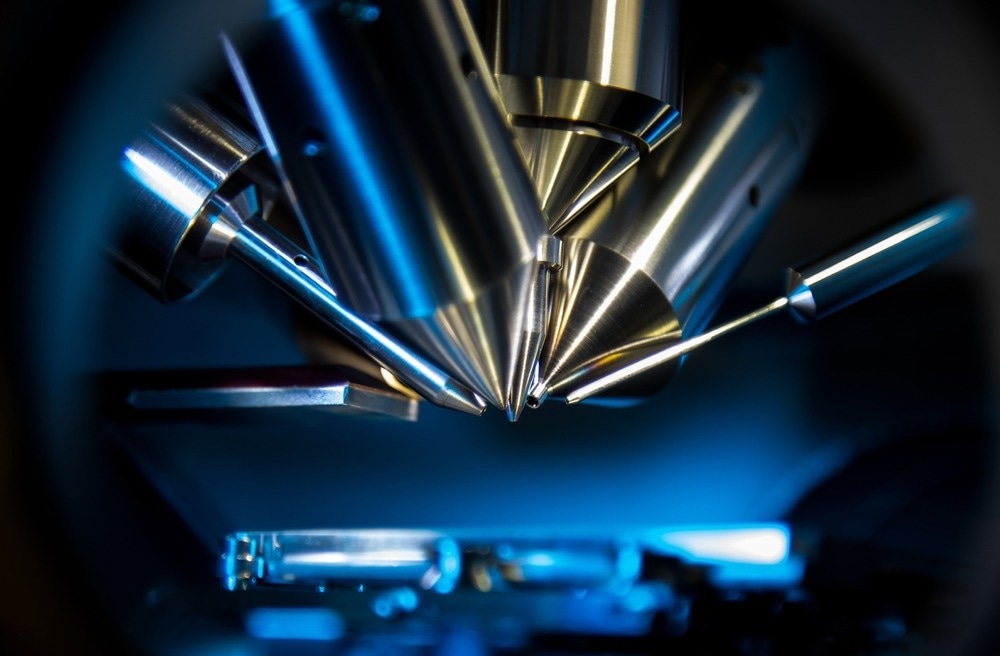The field of mass spectrometry (MS) involves measuring the mass of a certain species in a gaseous phase. Once a charge is applied to the species, the mass can be discerned by measuring the ratio between the two variables. This practice is used in almost all analytical chemistry and biology areas.

Image Credit: borzywoj/Shutterstock.com
Biological processes can be assayed in real-time, and chemical reactions can be monitored to finite details, all through the analysis of particles at an individual level. However, though the practice itself is more than a century old, certain limitations are fixed to these technologies.
Even before the actual use of the instrument, let alone the data analysis, there are still many factors to consider. To ensure an accurate reading, one must verify that the sample preparation, instrumentation, and software are all in working order, and even then, the analysis may still go astray. Fields such as proteomics, pharmacokinetics, and metabolomics are complex, and no standard operating procedures can be fixed upon all elements. Physical properties, cellular locals, abundance, and other natures of the analyte must all be considered during sample preparation and every subsequent step.
Limitations Brought About by Sample Preparation
A prime example of large time expenditures can be found in the laborious nature of sample preparation for proteomics. To ensure the instrument can properly read the specified analytes, various incubations, liquid transfers, reductions, alkylations, and cleavages must be performed, depending on the analyte's nature. This is all to ensure the proper proteins in the peptide mixture. In heterogeneous biofluids such as plasma, blood, or cerebrospinal fluid (CSF), we see 99% of the mass is taken up by a select few proteins, while trace elements remain relatively obscure.
Moreover, this variability in sample preparation also makes it quite hard to automate the workflow, a process that is becoming more prevalent in all areas of analytics. There are, however, manners in which this can be done, which can reduce the coefficients of variance, which in turn will generate more reliable statistical comparisons. The sample preparation must be meticulous to ensure that these trace elements are assayed properly. It is not uncommon for these samples to be traced to the parts per billion, and a great deal of funding has been invested in automation and AI machine learning algorithms.
How Sensitivity can Jeopardize the Readout
The reason that mass spectrometry is so widely used is because of the nature of its sensitivity. With quantitation devices like ion traps and particle multiplier tubes, MS instruments can perform very precise readings. However, this aspect of the instrument gives rise to one of its biggest flaws. The flow rate of these devices is moving at hundreds of nanoliters per minute. Measuring each nanoparticle within these flow rates is hard and almost impossible to perceive.
The real challenge presents itself when troubleshooting is required. Say that there is a leak in one of the many sections of this instrument, whether it be in the region of reagent ion selection, analyte ionization, or analyte quantitation. In such a rapid and narrow fluidic system, it becomes hard to visualize the flow, and finding such a leak becomes very difficult.

Image Credit: Intothelight Photography/Shutterstock.com
The Necessity for Expertise and the Intricacies of Instrumentation
Moving past the details of instrumentation, the user interface is quite complex. To operate an MS instrument effectively and to the highest caliber, an expert with more than a decade's worth of experience may often be called upon. Not only are readouts challenging for newer chemists/ biotechnicians to interpret, but changing the analyte may require a different apparatus entirely. Every species possesses a different polarity and molecular weight, meaning that some instrumentation may be better suited than others.
For example, larger molecules that are more polar are typically assessed using liquid chromatography coupled with MS, while smaller non-polar molecules are better suited for gas chromatography MS (GC-MS). The tuning of the instrumentation does not stop there, as there exist different column chemistries that are better suited to specific samples.
Column chemistries are altered using polar gradients and thermal gradients, calibration curves are often instated using an internal standard, and the nuances of all these details take years to understand, let alone perfect. Fortunately, we see the field veering from more technical aspects without compromising sensitivity. This serves the purpose of making the instrumentation more user-friendly.
There also exist restrictions on the time of analysis, with some samples taking as long as an hour to analyze correctly. The dead volume time, the loading of the device, and the flow time should all be factored in before the runs are even performed so that time management can be achieved.
Though all prior limitations still exist, the future of MS is looking very bright. With the advancements that are being made in next-gen sequencing, data algorithms, and statistical analysis, these cumbersome devices may even change into efficacious benchtop instruments that are easily assessable and easy to use.
Sources:
- Fu, Q., Johnson, C. W., Wijayawardena, B. K., Kowalski, M. P., Kheradmand, M., Van Eyk, J. E. (2020) A Plasma Sample Preparation for Mass Spectrometry using an Automated Workstation. J. Vis. Exp. (158), e59842, doi:10.3791/59842.
- John C. Lindon, George E. Tranter, David W. Koppenaal, R.E. March (2017) Ion Trap Mass Spectrometers. Encyclopedia of Spectroscopy and Spectrometry (Third Edition) 330-337. ISBN 9780128032244. https://doi.org/10.1016/B978-0-12-409547-2.12675-7.
- W. Clarke Hari Nair, William Clarke, (2017) Mass spectrometry in the clinical laboratory: determining the need and avoiding pitfalls. Academic Press. 1-15 ISBN 9780128008713. https://doi.org/10.1016/B978-0-12-800871-3.00001-8.
- Gert Lubec and Leila Afjehi-Sadat (2007) Limitations and Pitfalls in Protein Identification by Mass Spectrometry Chemical Reviews 107 (8), 3568-3584 DOI: 10.1021/cr068213f.
- Matsuda F. (2016) Technical Challenges in Mass Spectrometry-Based Metabolomics. Mass Spectrom (Tokyo). 2016;5(2):S0052. doi: 10.5702/massspectrometry.S0052. Epub 2016 Nov 25. PMID: 27900235; PMCID: PMC5121192.
Further Reading